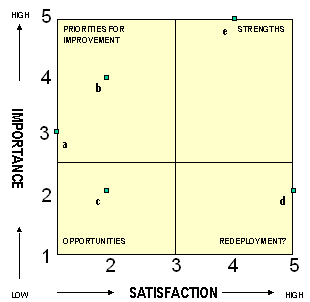Common menu bar links
Breadcrumb Trail
ARCHIVED - Service Improvement Initiative - Toolbox
 This page has been archived.
This page has been archived.
Archived Content
Information identified as archived on the Web is for reference, research or recordkeeping purposes. It has not been altered or updated after the date of archiving. Web pages that are archived on the Web are not subject to the Government of Canada Web Standards. As per the Communications Policy of the Government of Canada, you can request alternate formats on the "Contact Us" page.
Setting Priorities
The Satisfaction/Importance Matrix1
As noted in Step 4 in the How-to Guide: Setting Improvement Priorities, one way to determine priorities for service improvement is to create a service improvement matrix. This allows decision-makers to visualize potential areas for service improvement based on client survey responses through a plot of client satisfaction and the importance of each service element.
By plotting the two ratings on a two-dimensional grid, it can be quickly determined which improvements are both necessary (low satisfaction ratings) and important for clients (high importance ratings). The location of each service element plotted isolates those that are service improvement priorities (see the legend on the following page).
The following data illustrates the use of the matrix, based on the five-point scale of the CMT.
| Dimension of Service |
Satisfaction |
Importance |
|
|
a) |
Hours of service |
1 |
3 |
|
b) |
Comfort of waiting area |
2 |
4 |
|
c) |
Waiting times |
2 |
2 |
|
d) |
Parking |
5 |
2 |
|
e) |
Staff courtesy |
4 |
5 |

The Service Improvement Matrix
(also available in PDF (45KB) and RTF (106KB) format)
The Four Quadrants of the MatrixPriorities for Improvement. Service elements here have low satisfaction levels, but are the service dimensions which are also the most important to clients. These are the service elements that require immediate attention. Strengths. This contains those service elements that the client considers as important and has a high level of satisfaction. No improvement is required on this element. Redeployment? Elements in this quadrant have high satisfaction levels, but are not important to clients. No improvement is required to these service elements, or the opportunity may exist to reallocate of resources in support of other improvement priorities. Opportunities. Clients have low levels of satisfaction with these elements, but they are also not important. Improvements on these elements are not a priority at the moment. Note: By moving the crossed centre-lines of the matrix (up-down, left-right) how strict the improvement priorities are screened can be adjusted. The example on the previous page reflects such an adjustment. |
Based on the data in this example (which uses an adjusted centre-line), Hours of Service and Waiting Times emerge as improvement priorities.
When designing your questionnaires and testing them with focus groups, be sure to verify that you will get data to construct a service improvement matrix. As well, several priorities will likely emerge, or the priorities of minority groups may be squeezed out of the "Priorities for Improvement" quadrant. It is essential that the importance ratings are supported in the questionnaire with the question that asks respondents to identify their top priorities for improvement.
1 The description of the Service Improvement Matrix is taken from Listening to Customers: An Introduction prepared by S.A. Woodhouse et al. for the Service Quality B.C. Secretariat, Government of British Columbia, 1993. [return]
